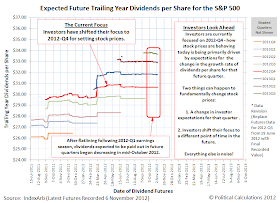The future has begun to change for the U.S. stock market. After mostly flatlining since the end of 2012-Q1's earning season, expectations for the amount of dividends expected to be paid in the future began to decline in mid-October 2012 as the outlook for dividends has worsened.
Meanwhile, when it comes to stock prices, investors appear to be focused on the very near term, with the change in the expected growth rate of trailing year dividends per share for the fourth quarter of 2012 setting the pace for the change in the year-over-year growth rate of stock prices for both October and November.
Until mid-October 2012, investors had appeared to be setting stock prices largely in tune with the change in the expected growth rate of dividends for the first quarter of 2013, the outlook for which is mildly positive. By contrast, the outlook for 2012-Q4 is moderately negative as it indicates that the growth rate of dividends is decelerating.
It also appears that the Fed's latest exercise in quantitative easing is failing to produce the same equity lifting effect it had in its previous two incarnations. Previously, we had observed that while the Fed was running its QE programs, the change in the growth rate of stock prices was well elevated above the expected change in the growth rate of future dividends per share.
This time however, we see that the changes in the growth rates of both stock prices and future dividends are not deviating from each other as they did in the Fed's earlier rounds of quantitative easing. That suggests the following possibilities:
- The Fed is doing it wrong. In the two previous rounds of QE, the Fed purchased large quantities of U.S. Treasuries. So far in this round, the Fed is only purchasing Mortgage Backed Securities. The stock market just doesn't get the same bang for the buck as when the Fed buys up Treasuries, which acts to reduce long-term interest rates across a wider swath of the economy, which is really what helped boost stock prices in earlier rounds.
- QE, as an effective policy, is running out of gas. The interest rates that the Fed might hope to lower in its QE programs started off at a much lower level, and a lot closer to their minimum zero level, than in its previous incarnations. With less room to maneuver, the Fed's actions just don't have the same oomph they once did.
Charles Hugh Smith offers more thoughts on the factors that might restrain the success for QE.

